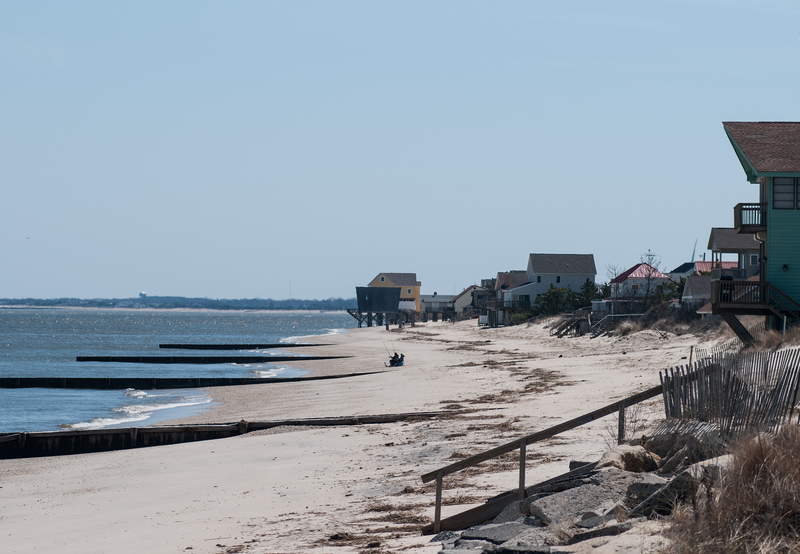Scientists: Benefits of replenishment outweigh losses
The horseshoe crab, whose ancestry dates back 450 million years, is far more resilient than any of Delaware's beaches.
So when nearly 2 million cubic yards of sand – which would cover one football field with sand three times the height of the Statue of Liberty – is pumped onto Broadkill Beach this year, it's inevitable that some young horseshoe crabs and eggs will be killed. But scientists say it won't be the end of the Delaware Bay population.
|
Project at a glance Timeline: April 2015 through April 15, 2016 Source: Army Corps of Engineers Philadelphia District |
|
|||
|
|
|
|
||
The replenishment at Broadkill is a sideline to the U.S. Army Corps of Engineers Philadelphia District's $310 million Delaware River Main Channel Deepening Project, which will dredge more than 102 miles of channel to increase the depth from 40 feet to 45 feet. Sand dredged from the southernmost portion of the channel work will be pumped onto Broadkill starting in April.
“The ones that will die will be the ones that get suffocated, and those will be the eggs and the juveniles that stay in the shallows,” explained Glenn Gauvry, founder of the Ecological Resource & Development Group that named Broadkill as Delaware's first Horseshoe Crab Sanctuary. “More than likely, the adults will be OK. The animal is alive to spawn another day.”
The channel deepening dredging project has been decades in the making, and throughout the last several years, state agencies and environmental groups, including the Department of Natural Resources and Environmental Control and Delaware Riverkeeper Network, have criticized the corps' plans.
Former DNREC Secretary Collin O'Mara, who is now the president and CEO of National Wildlife Refuge, initially denied a state-issued permit for the project, and questioned the validity of some of the corps' environmental assessments and sediment reports, stating in letters to the corps that reports were outdated or needed further sampling.
O'Mara said he doesn't oppose beach replenishment projects – they can have huge habitat values by improving the resiliency of threatened beaches.
“One of the concerns we had in 2009 was that a lot of these potential impacts hadn't been fully evaluated using current science,” O'Mara said in a recent interview.
“If we do nothing with these systems, they'll continue to erode, and there won't be sufficient habitat,” he said. “As long as you're sensitive to the impacts, if you're looking at how you protect the maximum number of species into the future, you can come up with solutions that are fairly low-impact.”
Special considerations for endangered Atlantic sturgeon and sea turtles have been taken, as well as plans for dealing with sandbar sharks and other sensitive species expected to be in the project area. But if every time-of-year restriction for every species were adopted, the corps would only have the first half of April to complete work at Broadkill, according to a 2010 response letter from the corps to the DNREC hearing officer.
“The Broadkill Beach project was designed for shore protection, not to benefit horseshoe crabs,” corps spokesman Richard Pearsall said.
“That said, beachfill projects have to pass environmental muster, too,” he said, and this one did, with both DNREC and U.S. Fish and Wildlife Service. “Borrow areas are chosen with the goal of matching the existing sand as closely as possible. Before we proceeded with what we consider a win/win situation here – deepening and shore protection – we made sure the sand is a suitable match. It should work to protect the shore and provide a new beach for horseshoe crabs to spawn.”
While some shrug off the effects of beach nourishment, others oppose the project. For former Broadkill Beach homeowner Antoinette Hastings, even one life lost is one too many.
When Antoinette Hastings bought a small beach home at Broadkill Beach in 1985, she couldn't walk on the beach without stepping on horseshoe crab shells.
“At the time, the horseshoe crab was a plague on all of us homeowners,” the former marine biology professor said. “But I already knew and loved them. I was adamant about not killing them.”
When she heard about the replenishment plans at Broadkill, she became concerned.
“Every time they replenished, we had very little of the routine critters we were used to having, at least for a year or two after replenishment,” Hastings said. “We're going to wipe out limulus and other equally precious species that live there.”
Hastings, who now lives in Lewes, said she crossed her fingers during the 21 years she lived at Broadkill, hoping her beach home wouldn't be wiped out by a massive storm. Her concern now is for the animals and plants that live and thrive along the shore, especially the horseshoe crab, she said. No matter how much sand is dumped, she said, Mother Nature is going to take its course.
“We're spitting in the wind,” she said. “Broadkill Beach is a barrier island. Nature never intended that as a permanent fixture. You can't prevent the storms from doing their thing.”
Current DNREC Secretary David Small said this replenishment is an opportunity for the state to take advantage of a beneficial coastal resiliency project. He acknowledged concerns for habitat, species and long-term results, which he said his department will monitor impacts as the project moves forward.
“It's a situation where we think the benefit far outweighs the concerns,” he said. “Being able to include Broadkill in a federal project, like we do with our ocean-coastline public beaches, is very beneficial to the state. Wider beaches mean more habitat. It means we will continue to provide that activity into the future in a way that benefits the environment as well as users of Broadkill Beach, the residents and the infrastructure.”
Project impact on horseshoe crabs
Broadkill Beach was the first in Delaware to be named a Horseshoe Crab Sanctuary, part of a community-based program through the Ecological Research & Development Group; although, the beach isn't the most active horseshoe crab spawning site in Delaware.
The last crab count during the 2012 spawning season estimated more than 622,000 horseshoe crabs at 13 Delaware Bay beaches. Only 13,290 – about 2 percent of Delaware's total – were counted at Broadkill Beach.
The impending beach fill project is one of many survival challenges for the 450-million-year-old creature. Horseshoe crab eggs and juvenile crabs are snacks for shorebirds, turtles, fish and anything else that is bigger than they are. Of 1 million eggs laid, only 30 will survive the first year.
Part of Weeks Marine's contract for pumping the sand includes measures to avoid killing crabs and other species within the project zone. At high tide, workers will be on hand to remove adult spawning crabs from the project area.
Any juveniles in the shallows or eggs laid within the project zone will most likely be killed or suffocated with sand, Gauvry said.
Broadkill Beach resident Jim Bailey said local residents are organizing to help the crabs. The group hopes to coordinate with the contractor to move the crabs at high tide, he said.
Gauvry said that while the project may make the beach more resilient, it probably will not have a significant impact on attracting more horseshoe crabs.
“This will not make it more productive,” he said. “The reason why it's not a high-producing beach is not because it doesn't have enough sand. It's not highly productive because it's too close to the mouth of the Delaware Bay. It will make it a more stable beach, so numbers on the beach will continue with no problem.”
|
Discrepancies with sand grain sizes Another difficult-to-predict outcome is whether dredged material will stay on Broadkill's beach face. Corps samples and a follow-up study prepared by DNREC and the University of Delaware in 2011, found that the dredged material from the lowest reaches of the channel deepening project, from which Broadkill will get it's new facelift, is much finer than what's currently found on the bay beach. It's not ideal, said geological sciences professor John Madsen, who co-authored the report, but it's better than no sand. “They certainly have a large volume of sediment to work with,” Madsen said. “It'll probably change the nature of the beach, but, ultimately, it will serve its purpose.” DNREC Secretary David Small said the new beach face is expected to create a more resilient beach front, which will not only protect properties along the barrier island, but also create better habitats for horseshoe crabs, shorebirds and other species. “I think we're going to do a pretty good job of minimizing those impacts,” he said. “We're cautiously optimistic that the material holds, and holds well. We're going to continue to monitor, over the longterm, any impacts it might have on horseshoe crab productivity in that area. It's a concern to bear watching into the future.” |
Project impact on sandbuilder worms
The replenishment also will bury local populations of the Sabellaria vulgaris, also known as the sandbuilder worm or reefworm, which creates elaborate reef-like sand structures along Delaware Bay beaches, including Broadkill Beach. These particular structures are not known to occur anywhere else in the world, with the exception of one similar sighting in the 1980s on a North Carolina shipwreck, but the worm species itself is very common.
Pumping 1.9 million cubic yards of sand on Broadkill will cover the existing reefs. Scientists say larvae living deeper in the bay will take their place over time, and that the worms usually don't settle into their reef structures until the fall.
University of Delaware associate professor Doug Miller said it won't be the first time Broadkill's reefs have been covered by a sand nourishment project; he predicts the worms will recover. Most likely, he said, the worms that lived in the reefs froze during low tides this winter.
It will take a while for them to rebound, Miller said, but after 20 years of observing the worms, he predicts that they will rebuild their reefs within 18 to 24 months. It would take about one inch of sand covering to suffocate live worms.
“The worms are a very resilient and adaptive species,” he said. “They've demonstrated that they're able to quickly reestablish themselves.”
Sandbuilder worm reefs are regularly found on the rock groins at Alabama Avenue in Broadkill Beach, Miller said. They also can be found on both the Delaware and New Jersey sides of the bay, including Fowlers Beach, Slaughter Beach, North Bowers Beach and near Port Mahon, Miller said.



























































